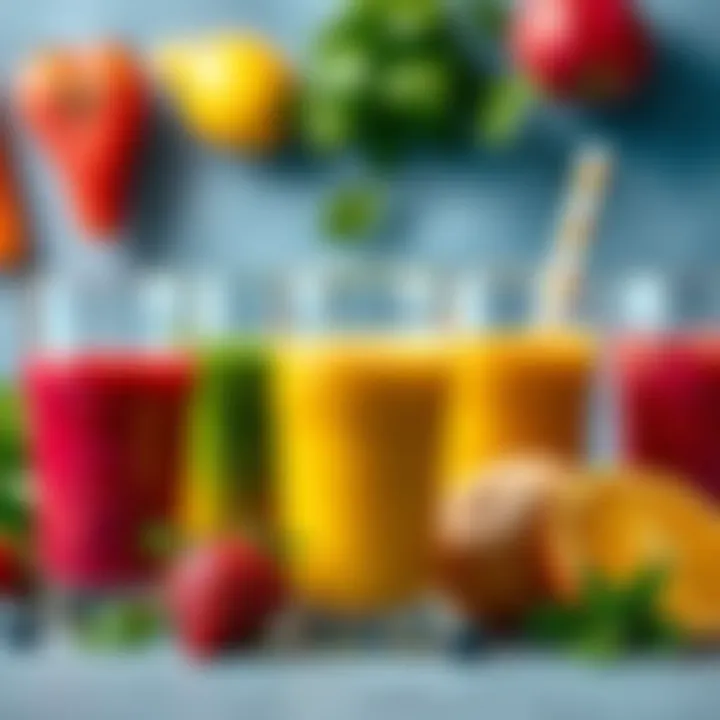Juicing for Weight Loss: A One-Week Guide


Intro
Juicing has gained traction in the health and wellness community for its purported ability to assist in weight loss over short periods. In just seven days, individuals often seek the transformative benefits of fresh juices, which promise not only to shed pounds but also to provide a wealth of nutrients. This article aims to dissect how juicing can be effectively employed as a tool for weight loss, outlining key juices, health benefits, and how you can weave juicing into your existing lifestyle without sacrificing nutrition.
In a world where quick fixes are often sought after, the concept of juicing as a rapid weight-loss solution has both avid supporters and skeptical onlookers. It’s essential to explore this method with a critical eye and a balanced perspective. This guide is designed to illuminate the process, providing insight into the nutritional strengths of various juices and practical tips to keep you on track.
While many equate juicing with magic potions for health, it’s about understanding the value of what you are consuming. Fresh juices, when made from the right ingredients, can be a powerhouse of vitamins and minerals. But, as with any dietary plan, there are challenges and considerations.
Furthermore, our approach also aims to address the potential pitfalls of juicing, helping readers navigate its limitations while still reaping its benefits. Understanding both the physical and mental health benefits, and integrating juicing into a well-rounded diet, can set the stage for a successful weight loss journey. Let's dive into how juicing can reshape your health in just a week and what it entails.
Prolusion to Juicing for Weight Loss
In today's fast-paced world, the pursuit of effective weight loss strategies has become a prominent topic of discussion. Juicing stands out as a method that some individuals find beneficial in their journey towards healthier living and weight management. By focusing on nutrient-dense liquids derived from fruits and vegetables, juicing offers a way to supply the body with essential vitamins and minerals while possibly assisting in cutting down extra pounds.
Juicing isn’t just about making a tasty drink; it’s a process that encourages participants to rethink their dietary habits. When individuals embark on a juicing plan, they often become more aware of the ingredients they consume. This mindfulness can result in healthier eating patterns beyond the juicing week, promoting sustainable habits that may lead to longer-lasting health improvements.
Understanding Juicing
Juicing involves extracting the liquid from fresh produce, providing a concentrated source of nutrients while eliminating the fiber typically present in whole fruits and vegetables. This method can deliver vitamins and minerals in a readily absorbable form, helping the body to utilize these nutrients more effectively. People often believe that sipping on a green juice or a fruit blend can give them a health boost in a matter of minutes.
However, it’s essential to understand that while juicing can be beneficial, it isn't universally applicable or suitable for everyone. Those with certain health conditions or dietary restrictions should consult professionals before diving into a juicing regimen. It's good to remember the famous saying, "One person's medicine is another's poison." Juicing must be adapted to individual needs and consulted upon with a health professional—there's no one-size-fits-all approach.
The Concept of Short-term Detox
Short-term detoxing through juicing can serve as a reset button for many. The idea is to temporarily eliminate processed foods and refined sugars, allowing the body to cleanse itself of accumulated toxins. This period offers not only a chance for physical rejuvenation but also a mental break from habitual eating patterns that might not always align with healthier choices.
Despite the potential detoxification benefits, it might assist to approach juicing carefully during this period. Some may experience side effects like fatigue, headaches, or digestive disturbances as their bodies adjust to the lack of solid food intake. It’s key to stay hydrated, listen to one’s body, and if necessary, ease off the juicing approach while incorporating some soft foods for balance.
"Detox isn't just about what you take out; it’s also about what you put in."
In essence, juicing for weight loss offers both immediate and long-term gains, provided individuals are aware of their unique needs and approach it with a well-informed perspective. This journey towards healthier eating can be enlightening, translating into a more profound understanding of one's body and its needs.
The Science Behind Juicing
Understanding the scientific underpinnings of juicing is crucial for anyone considering this method for weight loss. The primary focus lies in the nutrients that juices provide, as well as their broader effects on the body. An effective juicing plan can harness these elements, transforming the way we approach not just weight loss, but also overall health. It’s not merely about celery and carrot blends; it’s about what these combinations do for body functions—from digestion to energy metabolism.
Juicing can be an instantaneous way to deliver vitamins, minerals, and antioxidants into the bloodstream. These compounds play a significant role in enhancing cellular functions and overall health, making knowledge of their nutritional profiles essential for crafting a methodical juicing plan.
Nutritional Profile of Juices
Juices can take on many forms, depending on the ingredients chosen. Each fruit and vegetable harbors its own unique set of vitamins and minerals, which contribute differently when consumed in liquid form. Here are a few key nutrients often found in juice:
- Vitamins: Higher concentrations of vitamins A, C, and several B vitamins are typical in fruit and vegetable juices. These help in repairing tissues and boosting the immune system.
- Minerals: Essential minerals such as potassium and magnesium support heart function and muscle contractions.
- Antioxidants: Powerful compounds, like flavonoids and carotenoids found in berries and leafy greens, assist in fighting inflammation and oxidative stress.
- Fiber Content: While juicing removes a lot of fiber, some juices retain it, which can aid digestion and help you feel full longer.
The combination of these nutrients can provide an impressive health boost, supporting the body as it undergoes weight loss. For example, using kale in a juice provides a significant amount of Vitamin K, essential for bone health, while also supplying antioxidants that fight off free radicals.
Effect on Metabolism
The metabolic response to juicing can vary based on the types of ingredients used. Fresh vegetable juices tend to have a lower glycemic index than fruit juices, making them a better choice for sustained energy levels without spikes in blood sugar. This steadiness is particularly crucial when aiming to lose weight, as fluctuations can lead to cravings and overeating.
- Boosting the Basal Metabolic Rate (BMR): Certain ingredients like green pepper and broccoli might increase the BMR due to their high nutrient density and low-calorie count, providing energy without excess.
- Digestive Processes: Juicing can simplify digestion, giving the gastrointestinal system a break, allowing it to process nutrients more efficiently. This ease can help anyone aiming to shed pounds without overcomplicating their diets.
- Hormonal Balance: Some juices, like those made from beets, have been shown to support hormone health, which can directly relate to metabolism and fat storage.
Incorporating a variety of juices that focus on nutrient density may help foster not just weight loss but an overall improvement in health as well.
Planning Your Juicing Week


When it comes to embarking on a juicing journey for weight loss, planning is half the battle. Properly organizing your juicing week will not only enhance your overall experience but also set you up for success. Having a game plan helps to create a sense of structure, ensuring that you stay on track and avoid any pitfalls that might arise along the way.
Establishing a detailed juicing schedule allows for effective tracking of your focused goals. Furthermore, having recipes and ingredient lists readily available makes it easier to stay consistent. This proactive approach reduces the likelihood of making impulsive choices that could derail your weight loss progress.
Selecting the Right Ingredients
Fruits for Sweetness
Fruits play a vital role in juicing. They provide a natural sweetness, which can make the experience more enjoyable. Fruits like apples, oranges, and pears are delightful choices. Their high sugar content offers an immediate boost of energy while satisfying your taste buds.
What makes fruits particularly appealing is their variety of flavors and textures. They present a unique opportunity to mix and match based on preference. Furthermore, most fruits are rich in vitamins, which can help you feel full and energized. Yet, moderation is key since excess sugar can manifest as extra calories.
Vegetables for Nutrients
Vegetables are the unsung heroes of the juicing world. They bring a wealth of nutrients without the added sugars commonly found in fruits. Kale, spinach, and carrots are key contenders here. Their dense nutrient profile offers vitamins and minerals essential for bodily functions.
The challenge lies in their robust flavors. Some people find that certain vegetables can be bitter or overwhelming. That said, blending them with sweeter fruits can effectively balance this out. The bottom line is that vegetables add not just nutrients but a variety of colors and textures, making your juices aesthetically pleasing and nourishing.
Herbs and Spices
Incorporating herbs and spices into your juices can enhance both flavor and health benefits. Fresh herbs like mint, basil, and cilantro, as well as spices like ginger and turmeric, can add a delightful zest to your blends. They bring a remarkable quality: not only do they enliven flavors, but they also pack various health benefits, from anti-inflammatory properties to digestive support.
The beauty of herbs and spices is that they can easily elevate the most basic juice recipes. However, they should be used wisely—as strong flavors can dominate the palate. Introducing just a pinch can turn a simple juice into something extraordinary, all while making it more beneficial.
Daily Juice Recipes
Morning Boost Juice
Starting your day with the right nourishment is crucial. The Morning Boost Juice often contains fruits such as oranges and strawberries, paired with greens like spinach. This combination is specifically crafted to spark energy in the early hours, helping you kickstart your metabolism for the day. Additionally, the vitamin C from citrus fruits aids in waking up the immune system.
One characteristic of this juice is its refreshing taste, ideal for perking you up. However, if you find yourself rushing in the morning, preparing it a day in advance might help. Just be cautious; juicing too far ahead may reduce the nutrient density over time.
Noon Refresh Juice
By midday, you might feel a slump. The Noon Refresh Juice can act as your midday pick-me-up. This usually combines watery fruits like cucumber and watermelon with some mint leaves to introduce a cooling effect. It helps in hydrating the body while providing a light meal.
A standout feature of this juice is its rejuvenating nature; it clears the mind and prepares you for the afternoon hustle. It's crucial, however, to keep your serving size moderate since it should complement rather than replace full meals.
Evening Cleanse Juice
As the day winds down, the Evening Cleanse Juice steps in. This juice typically brings in ingredients known for their detoxifying abilities, such as beetroot and celery. It’s intended to support your body’s natural detox process.
The key characteristic of this juice is its earthy flavor, which some may find unappealing. Therefore, balancing it with a hint of apple or lemon can make a significant difference. Evaluating how the juice interacts with your evening routine can help you determine its place in your overall juicing regimen.
Consider this: Planning means more than just setting a menu; it's the roadmap to achieving your health goals.
By carefully choosing ingredients and crafting specific recipes, the goal is to create a delightful and effective juicing experience that dovetails with your weight loss efforts. The aforementioned recipes and ingredient selections create a balanced framework to foster successful juicing habits.
Incorporating Juicing into Daily Life
Juicing can be a game changer for those seeking weight loss while also aiming to nourish their bodies. However, making juicing a staple of daily routines requires thoughtful consideration. Understanding how to blend juicing harmoniously into one’s lifestyle can enhance its effectiveness and sustainability.
When thinking of incorporating juicing, it’s essential to recognize that this is more than just a temporary diet. It’s about establishing a balanced approach that facilitates positive habits over time. Juicing provides essential nutrients and helps detoxify the body, but it must be seen as a part of a larger picture of health, rather than the sole solution. Finding that balance boosts both weight loss and overall well-being.
Creating a Juicing Schedule


Establishing a juicing schedule is like drafting your roadmap for success. This plan is necessary to ensure consistency and maintain momentum. It allows you to incorporate various juices thoughtfully throughout the week without overwhelming yourself.
Consider the following tips when making your juicing schedule:
- Set a Time: Choose a set time each day to juice, be it in the morning to kickstart your day, or perhaps after a workout.
- Week Ahead Planning: Dedicate time each week to plan your juices. Doing this helps remove the guesswork and keeps you on track.
- Mix It Up: Rotate your juice recipes every few days to keep things interesting. Don’t shy away from experimenting with different flavors and ingredients.
A sample weekly schedule might look like this:
- Monday: Morning Boost Juice (apple, spinach, ginger)
- Tuesday: Noon Refresh Juice (cucumber, lemon, mint)
- Wednesday: Evening Cleanse Juice (beet, carrot, celery)
By implementing a schedule, you maintain a certain rhythm that keeps you engaged while also allowing flexibility as needed.
Balancing Juices with Solid Foods
While juicing provides an impressive array of nutrients, it shouldn’t be a complete replacement for solid food. A balanced approach can maximize the benefits of juicing and help maintain long-term weight loss. Integrating solid foods into your diet means ensuring that you still receive essential fibers and proteins not present in juices.
- Strategic Pairings: Like a duet, juices and solid foods can complement each other beautifully. Pairing a substantial lunch with a lighter juice in the afternoon can aid digestion and appetite control. Think of a quinoa salad followed by a zesty orange-carrot juice.
- Healthy Snacks: Keep some nutritious snacks on hand to bridge the gap between juicing intervals. Nuts, seeds, and fruits fit the bill nicely.
- Listen to Your Body: Pay attention to how different combinations of solid foods and juices impact your energy levels and satiety. Adjust portions and pairings accordingly.
A gentle reminder is to tailor your meal plan around the juicing schedule. This step maintains hydration, satisfies hunger, and ensures you’re not missing out on important nutrients. Incorporating juicing into your life doesn't mean abandoning solid foods; rather, it means striking a balance that works for you.
"The goal is to team up juicing with a well-rounded diet. It's not about extremism, but harmony in what you consume."
Monitoring Progress and Adjustments
Tracking your journey during a juicing regimen is essential for reaching your weight loss goals. It goes beyond merely getting on a scale each morning. Think of progress monitoring as the compass guiding your path through what can be an uncertain yet transformative week. It helps you make informed decisions and adjust your approach based on how your body reacts to this new routine.
Tracking Weight Loss and Health Indicators
First and foremost, you need a clear method for tracking progress. Weigh yourself regularly, but not too frequently. Once a week might be just right. This gives you time to see real changes, rather than daily fluctuations caused by water retention or other variables. In addition to weight, pay attention to your body measurements. Waist circumference, hip measurements, and even how your clothes fit can be more telling than the number on the scale alone.
Incorporating health indicators into your tracking is vital. Evaluate how you feel overall. Are you experiencing higher energy levels? Better digestion? Perhaps clearer skin? These factors are important in assessing your overall wellbeing and the effectiveness of your juicing plan. Furthermore, keeping a food journal can provide insights into how your body responds to each juice. Noting when you feel hungry, satisfied, or bloated can highlight patterns that might need adjustment.
Responding to Body Signals
Listening to your body is akin to being in a dance with it. When you start juicing, your body may react in surprising ways. You might find that certain juices agree with you while others do not. For instance, if you notice discomfort or bloating after consuming a particular juice, it might be time to reconsider the ingredients or portion sizes. Adapting your regimen based on these signals is critical.
Moreover, energy levels can be a big indicator. If you’re feeling sluggish or overly fatigued, adding a few more nutrients through solid food might be beneficial. Conversely, if you’re feeling great, that’s an encouraging sign that you’re on the right track. You may even discover particular cravings that signal a need for specific nutrients, showing the importance of flexibility in your juicing week.
Maintaining a level of self-awareness throughout this process aids not only in achieving your weight loss goals but also in fostering a healthier relationship with food. This journey is not just about losing weight—it is about understanding your body’s needs and learning how to nourish it effectively.
"Listening to your body is not merely a practice of being in-tune, it’s an art of knowing when to adjust and adapt."
Taking time to monitor progress and make necessary adjustments during your juicing experience can greatly enhance the benefits you reap from it. Your body is your ultimate guide; it knows what it needs better than any diet plan ever will.
Potential Challenges and Solutions
Juicing can seem like a cakewalk at first glance, especially with all the colorful images of fresh juices bursting forth from social media. However, there are a few bumps on the road that many encounter when embarking on a juicing journey. Understanding these potential challenges and being prepared to tackle them is key to ensuring you squeeze every drop of success from your week of juicing.
Common Side Effects of Juicing
Nutritional Deficiencies
One of the most significant risks associated with an exclusive juicing diet is the possibility of nutritional deficiencies. Juices, while packed with many vitamins and minerals, often lack adequate amounts of certain nutrients essential for your overall health. When you restrict your diet to just juices, you may not get enough protein, healthy fats, or fiber, all of which are crucial to maintain energy levels and keep bodily functions running smoothly. A deficiency in protein, for example, can lead to muscle loss and decreased metabolism, which isn't exactly the goal when trying to shed pounds.
It’s important to be conscious of these gaps in your nutrition. Some people think that juicing is a panacea for their dietary woes, but it’s easy to overlook what’s missing. Balancing your juices with solid foods can prevent these deficiencies, helping your body feel its best while you're on this journey. Supplementing your juicing with items like nuts, lentils, or whole grains can pack a punch without derailing your progress.


Digestive Issues
Digestion can also take quite a hit during a week of juicing. While fresh juices smooth out the path for some, the sudden influx of sugars from fruits can lead to digestive distress for others. Bloating, gas, and cramping are common complaints, and they can hinder motivation and alignment with your juicing goals. The fiber that regular foods provide is significantly reduced, which can lead to a sluggish gut, even for those who generally have no digestive issues.
It’s a double-edged sword, really. While juices can revitalize and cleanse, they can also provoke discomfort if your body isn’t accustomed to such a drastic shift in diet. To combat this, introduce your juices gradually, allowing your digestive system to acclimatize. Continuous hydration and occasional lighter meals can help ease the transition.
Maintaining Motivation
One of the toughest parts of any diet is staying motivated throughout the process. Juicing can feel like a sprint at the start but may turn into a slog once the novelty wears off. To keep your spirits high, it’s beneficial to set small, attainable goals throughout the week. This can include tracking your progress in a journal or joining a community focused on juicing. Surrounding yourself with like-minded individuals can provide support and make you feel part of a collective journey. Celebrating small successes provides that extra spark you might need to keep trudging through the challenges ahead.
Motivation isn't just about the end goal; it's about the small victories that keep pushing you along the path.
Finally, remember that juicing is just a part of a bigger picture for health. Reflecting on why you started this journey can reignite your passion and determination to see it through. It's all part and parcel of making juicing not just another fad, but a step toward a more balanced lifestyle.
Long-term Considerations
When embarking on a weight loss journey, particularly through juicing, it’s crucial to consider the long-term implications beyond the initial seven-day plan. Zipping through a week of juicing can bring about rapid results, but without a foundation for sustaining healthful habits, these gains may be fleeting. Long-term considerations delve into how to integrate juicing into your daily routine and the continual benefits it can offer your overall wellness.
Juicing as a Lifestyle
Integrating Juicing Beyond Seven Days
Incorporating juicing into your life past the initial week is about more than just continuing to sip on your favorite blends. It becomes an act of nourishment, not merely a temporary fix. Many people find that integrating juices into their daily meals can lead to a vibrant boost in energy and nutrient intake. Rather than seeing juicing as an isolated endeavor, treating it as part of your regular diet can help ensure sustained outcomes.
Consider this: many individuals choose not only to maintain their juice consumption but to adapt their recipes. Folks may start adding other nutritious elements, like nuts or seeds, to their juices or utilizing less common ingredients such as beets or kale. This diversification not only keeps things fresh but also exposes your body to a wider range of vitamins, minerals, and phytonutrients.
Yet, it’s important to balance these juices with solid foods to avoid potential nutritional gaps. People may struggle initially, but the good news is that starting slow, perhaps with a few juices a week, can lead to more successful adherence. It's a long-term game—building habits that support a healthier lifestyle can yield benefits that go beyond just your waistline.
Continuous Health Benefits
The continuous health benefits of juicing stem from the consistent intake of fresh fruits and vegetables, which are known powerhouses of essential nutrients. As you incorporate juices into your regular diet, you may find yourself feeling more vibrant and alert. Juicing can lead to improvements in digestion due to the influx of dietary fiber, particularly when using whole fruits alongside their juices.
One interesting aspect to consider is how juicing can contribute to better skin health. Many users mention an observable improvement in skin tone and texture after regularly consuming nutrient-rich juices. This can be attributed to the antioxidants and vitamins that help combat oxidative stress, promoting overall skin vitality.
However, it’s also important to be vigilant about your overall dietary balance. Juicing shouldn't replace all solid food, as whole foods contribute different fibers and satiation effects. Thus, while the advantages of juicing are significant, being mindful of its role within a larger dietary framework is critical for long-term success.
Evaluating Effectiveness
Determining the effectiveness of juicing as a weight loss method requires introspection and measurement. Keeping a record of your weight, energy levels, and general health indicators can provide insights into how well the approach is working for you. Reflect on your progress after the seven days and consider aspects such as mental clarity and mood. If weight loss is your goal, what shifts have you noted? Have they been lasting, or do you find the scale bouncing back?
Ultimately, evaluating effectiveness is less about numbers alone but about how juicing fits into your life. This journey is uniquely yours, and understanding how it works—not just for weight loss, but for holistic health—will shape whether juicing becomes a long-term player in your wellness routine.
"Sustainability is the quiet friend to health; without it, all efforts can unwind."
The End and Final Thoughts
As we wrap up the conversation on juicing for weight loss, it's clear that this approach offers more than just a quick fix for shedding pounds. The journey over the past week touches on significant aspects of nutrition, body awareness, and personal commitment. At its core, juicing serves as a catalyst, pushing you to reevaluate and potentially overhaul your dietary habits. It's not merely about juice; it goes deeper into the understanding of how what we consume influences our overall health and wellbeing.
Recap of Key Insights
Throughout this article, we've covered a wide range of critical points that underscore the importance of juicing as a weight loss strategy:
- Nutritional Density: Juices are packed with essential vitamins and minerals that might otherwise be lacking in a typical diet. Incorporating the right ingredients can provide a concentrated source of nourishment.
- Detoxification: Engaging in a week of juicing can help your body detox naturally, flushing out toxins and enhancing digestive health.
- Mindful Eating: Juicing encourages you to be more mindful about what you consume, especially balancing solid and liquid meals effectively. This awareness can lead to healthier long-term choices.
- Weight Management: While short-term weight loss can be noticeable, the true goal should be maintaining that progress through sustainable eating habits after the juicing week.
Invitation to Explore Your Journey
Embarking on a journey into juicing means more than just trying out a new fad. It's an opportunity to nurture a better relationship with food. As you consider the next steps after this week, think about how you can incorporate these juices into a sustainable regimen. Perhaps start with a few servings each week, or set aside a day for juices to cultivate a cleansing routine. Don't shy away from trying new recipes, experimenting with flavors, and evaluating what feels best for your body.
"Onward to understanding your body’s needs is the foundation for any health journey." This exploration does not need to be solitary. Engage with communities, share experiences, and encourage others while learning from their insights. Resources like Reddit Health and various Facebook groups can provide support and new ideas.
Finally, remember that each body is unique. What works well for one person may not suit another. Trust your journey and adjust your path according to your experiences and results. Let this week be just the beginning, opening doors to a healthier lifestyle.













